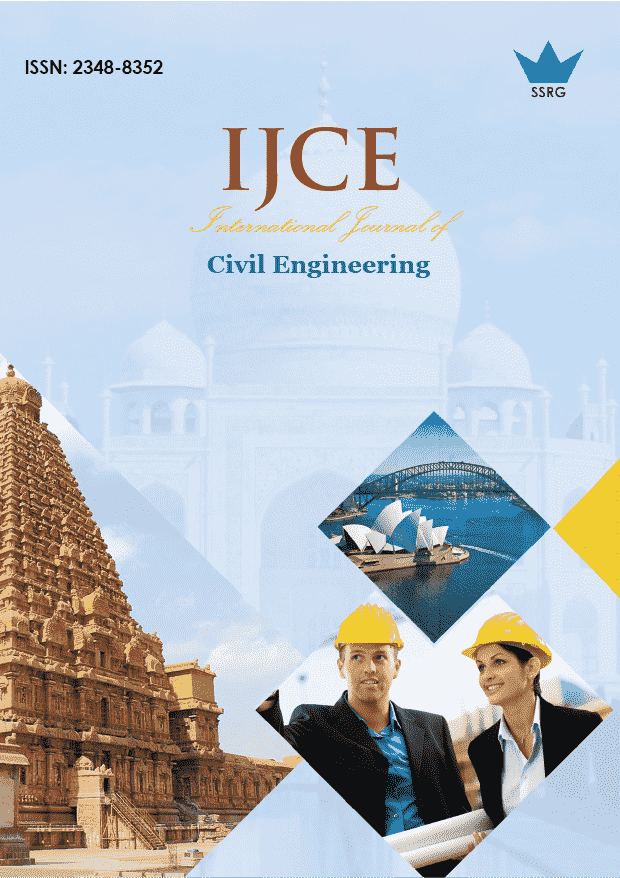Evaluation of the Mechanical Properties of Adobe with the Addition of Rice Husk Ash and Opuntia Ficus-Indica

| International Journal of Civil Engineering |
| © 2025 by SSRG - IJCE Journal |
| Volume 12 Issue 10 |
| Year of Publication : 2025 |
| Authors : Jhoan Antony Pizarro Ricaldi, Jose Armando Porras Chavez, George Joseph Meza Parian, Manuel Ismael Laurencio Luna |
How to Cite?
Jhoan Antony Pizarro Ricaldi, Jose Armando Porras Chavez, George Joseph Meza Parian, Manuel Ismael Laurencio Luna, "Evaluation of the Mechanical Properties of Adobe with the Addition of Rice Husk Ash and Opuntia Ficus-Indica," SSRG International Journal of Civil Engineering, vol. 12, no. 10, pp. 76-96, 2025. Crossref, https://doi.org/10.14445/23488352/IJCE-V12I10P107
Abstract:
Raw Earth continues to be a widely used material in rural construction due to its accessibility and low cost; however, Adobe has significant limitations, such as its low mechanical strength and high vulnerability to moisture, which negatively affect its durability and structural safety. In view of this problem, this research aimed to evaluate the effect of incorporating Rice Husk Ash (RHA) and Prickly Pear Juice (Opuntia ficus-indica, PPJ) on the mechanical, physical, and thermal properties of Adobe, with a view to developing a more sustainable and environmentally friendly alternative. To this end, soil extracted from the Cullpa Alta quarry, located in the district of El Tambo, was used and classified according to the SUCS system. As for the additives, RHA was obtained through a process of controlled calcination and subsequent sieving of rice husks, while PPJ was prepared from the collection, washing, cleaning, and blending of prickly pear cactus pads. Next, six dosage levels were tested for both additives (RHA: 0%, 2%, 4%, 6%, 8% and 10%; PPJ: 0%, 10%, 11.5%, 13%, 14.5% and 16%), resulting in 210 samples that were subjected to compressive strength, tensile strength and flexural strength tests, as well as tests on adobe walls, water absorption and thermal conductivity. As a result, the combination of 6% RHA with 13% PPJ proved to be the most effective, achieving increases of 65.85% in compression, 294.37% in traction, 98.73% in flexion, and 159% in walls, as well as reductions of 47.46% in water absorption and 43.44% in thermal conductivity. Finally, an ANOVA analysis verified that these improvements were statistically significant (p < 0.05), demonstrating that the incorporation of these natural additives allows for a comprehensive improvement of traditional Adobe, positioning this alternative as a viable, durable, and environmentally friendly construction solution.
Keywords:
Ficus-Indica, Rice Husk Ash, Adobe, Thermal Conductivity.
References:
[1] Issiaka Sanou et al., “Effect of the Coconut Fibers and Cement on the Physico-Mechanical and Thermal Properties of Adobe Blocks,” Heliyon, vol. 10, no. 19, pp. 1-15, 2024.
[CrossRef] [Google Scholar] [Publisher Link]
[2] Yask Kulshreshtha et al., “The Potential and Current Status of Earthen Material for Low-Cost Housing in Rural India,” Construction and Building Materials, vol. 247, pp. 1-14, 2020.
[CrossRef] [Google Scholar] [Publisher Link]
[3] Ginés A. Abanto et al., “Thermal Properties of Adobe Employed in Peruvian Rural Areas: Experimental Results and Numerical Simulation of a Traditional Bio-Composite Material,” Case Studies in Construction Materials, vol. 6, pp. 177-191, 2017.
[CrossRef] [Google Scholar] [Publisher Link]
[4] T. Li Piani, J. Weerheijm, and L.J. Sluys, “Critical Review on the Material Characterization of Adobe Elements,” Journal of Green Building, vol. 17, no. 3, pp. 203-226, 2022.
[CrossRef] [Google Scholar] [Publisher Link]
[5] Julio Vargas-Neumann et al., “Seismic Retrofit of Adobe Constructions,” Strengthening and Retrofitting of Existing Structures, vol. 9, pp. 85-111, 2018.
[CrossRef] [Google Scholar] [Publisher Link]
[6] Luis Fernando Guerrero Baca, “The Use of Cob in the Intervention of Adobe Construction Components,” Intervención, vol. 11, no. 22, pp. 133-187, 2020.
[CrossRef] [Google Scholar] [Publisher Link]
[7] Javier Camacho Tauta, Claudia Uribe-Kaffure, and Alfonso Ramos-Cañón, “Mechanical Deterioration due to Weathering of the Adobe of the Tausa Chapel (Colombia),” TecnoLógicas, vol. 26, no. 58, pp. 1-16, 2023.
[CrossRef] [Google Scholar] [Publisher Link]
[8] G. Araya-Letelier et al., “Waste-Based Natural Fiber Reinforcement of Adobe Mixtures: Physical, Mechanical, Damage and Durability Performance Assessment,” Journal of Cleaner Production, vol. 273, 2020.
[CrossRef] [Google Scholar] [Publisher Link]
[9] National Institute of Statistics and Informatics, 2025. [Online]. Available: https://m.inei.gob.pe/prensa/noticias/produccion-de-arroz-cascara-alcanzo-220-mil-toneladas-y-aumento-en-50-durante-enero-de-2023-14320/
[10] Kamlesh Kumar, Dhurendra Singh Rama, and R.S. Singh, Cactus Pear: Cultivation and Uses, Technical Bulletin, pp. 1-38, 2018.
[Google Scholar]
[11] José Amador Honorato-Salazar, Jorge Aburto, and Myriam Adela Amezcua-Allieri, “Agave and Opuntia Species as Sustainable Feedstocks for Bioenergy and Byproducts,” Sustainability, vol. 13, no. 21, pp. 1-18, 2021.
[CrossRef] [Google Scholar] [Publisher Link]
[12] Mugahed Amran et al., “Rice Husk Ash-Based Concrete Composites: A Critical Review of Their Properties and Applications,” Crystals, vol. 11, no. 2, pp. 1-30, 2021.
[CrossRef] [Google Scholar] [Publisher Link]
[13] D.M. Gomez Mejia et al., “Effect of the Addition of Silica Obtained from Rice Husk on Physicochemical and Mechanical Properties of Fibercement,” Heliyon, vol. 9, no. 2, pp. 1-13, 2023.
[CrossRef] [Google Scholar] [Publisher Link]
[14] V. Jittin, A. Bahurudeen, and S.D. Ajinkya, “Utilisation of Rice Husk Ash for Cleaner Production of Different Construction Products,” Journal of Cleaner Production, vol. 263, 2020.
[CrossRef] [Google Scholar] [Publisher Link]
[15] Juan Carlos Guevara-Arauza, “Industrial Uses of Opuntia Spp. By-Products,” Opuntia Spp.: Chemistry, Bioactivity and Industrial Applications, pp. 707-752, 2021.
[CrossRef] [Google Scholar] [Publisher Link]
[16] Issiaka Sanou et al., “Mineralogy, Physical and Mechanical Properties of Adobes Stabilized with Cement and Rice Husk Ash,” Science Journal of Chemistry, vol. 7, no. 1, pp. 1-10, 2019.
[CrossRef] [Google Scholar] [Publisher Link]
[17] Shantanu Paul, Mohammad Shariful Islam, and Tausif E. Elahi, “Potential of Waste Rice Husk Ash and Cement in Making Compressed Stabilized Earth Blocks: Strength, Durability and Life Cycle Assessment,” Journal of Building Engineering, vol. 73, 2023.
[CrossRef] [Google Scholar] [Publisher Link]
[18] Olubisi Ige, and Humphrey Danso, “Experimental Characterization of Adobe Bricks Stabilized with Rice Husk and Lime for Sustainable Construction,” Journal of Materials in Civil Engineering, vol. 34, no. 2, 2021.
[CrossRef] [Google Scholar] [Publisher Link]
[19] Moussa Ouedraogo et al., “Microstructure, Physical and Mechanical Properties of Adobes Stabilized with Rice Husks,” International Journal of Architectural Heritage, vol. 17, no. 8, pp. 1348-1363, 2023.
[CrossRef] [Google Scholar] [Publisher Link]
[20] Mohamed I. Morsy et al., “Recycling Rice Straw Ash to Produce Low Thermal Conductivity and Moisture-Resistant Geopolymer Adobe Bricks,” Saudi Journal of Biological Sciences, vol. 29, no. 5, pp. 3759-3771, 2022.
[CrossRef] [Google Scholar] [Publisher Link]
[21] Magdy F. Abadir et al., “Preparation of Adobe Brick by Mixing with Rice Hush Ash,” International Journal of Technical Research & Science, vol. 3, no. 6, pp. 206-221, 2018.
[CrossRef] [Google Scholar] [Publisher Link]
[22] S. Mbairangone et al., “Effects of Rice Husk on Adobes in Clay Soils,” Research Journal of Engineering Sciences, vol. 11, no. 3, pp. 12-21, 2022.
[CrossRef] [Google Scholar] [Publisher Link]
[23] Sasui Sasui, Watcharin Jinwuth, and Sirimas Hengrasmee, “The Effects of Raw Rice Husk and Rice Husk Ash on the Strength and Durability of Adobe Bricks,” Civil Engineering Journal, vol. 4, no. 4, pp. 732-742, 2018.
[CrossRef] [Google Scholar] [Publisher Link]
[24] Sasui et al., “A Study on Improving the Strength Properties of Adobe Brick with the use of Agriculture Waste Stabilizer,” Proceedings of the Korean Institute of Building Construction Conference, pp. 25-26, 2019.
[Google Scholar] [Publisher Link]
[25] Sutham Rotchanameka, Attapole Malai, and Prachoom Khamput, “The Effect of Natural Fibers and Para Rubber Latex on Adobe Bricks,” Rattanakosin Journal of Science and Technology, vol. 6, no. 2, pp. 99-109, 2024.
[Google Scholar] [Publisher Link]
[26] F. Fernandez et al., “Use of Prickly Pear (Nopal) Mucilage in Construction Applications: Research and Results,” Life Safety and Security, vol. 12, no. 1, pp. 1-11, 2024.
[CrossRef] [Google Scholar] [Publisher Link]
[27] Socrates Pedro Muñoz Pérez et al., “Influence of Prickly Pear Gum on the Physical and Mechanical Properties of Adobe Reinforced with Palm Fiber,” Engineering and Applied Science Research, vol. 51, no. 4, pp. 495-504, 2024.
[CrossRef] [Google Scholar] [Publisher Link]
[28] Flavia Cristina Castillo Bacalla, Juan Martín García Chumacero, and Luis Mariano Villegas Granados, “Improvement of Adobe Brick Reinforced with Sugarcane Bagasse Fiber, Rice Husk, and Metal Mesh: Study in Peru,” Innovative Infrastructure Solutions, vol. 10, no. 5, pp. 1-13, 2025.
[CrossRef] [Google Scholar] [Publisher Link]
[29] Danilo Servando Carrasco Pacheco et al., “Influence of Rice Husk and Cabuya Fiber on the Physical and Mechanical Properties of Adobe,” Engineering and Applied Science Research, vol. 52, no. 1, pp. 112-124, 2025.
[CrossRef] [Google Scholar] [Publisher Link]
[30] S. Ramakrishnan et al., “Adobe Blocks Reinforced with Natural Fibres: A Review,” Materials Today Proceedings, vol. 45, pp. 6493-6499, 2021.
[CrossRef] [Google Scholar] [Publisher Link]
[31] Lola Ben-Alon et al., “Cradle to Site Life Cycle Assessment (LCA) of Natural vs Conventional Building Materials: A Case Study on Cob Earthen Material,” Building and Environment, vol. 160, 2019.
[CrossRef] [Google Scholar] [Publisher Link]
[32] M. Lenin Lara, and Rosa Bustamante, “Characterization and Pathology of Earthen Building Walls in the Ecuadorian Andean Area,” Polytechnic Magazine, vol. 49, no. 2, pp. 37-46, 2022.
[CrossRef] [Google Scholar] [Publisher Link]
[33] Lily Walter et al., “Design of Poured Earth Construction Materials from the Elementary Characteristics of Tropical Soils,” Case Studies in Construction Materials, vol. 20, pp. 1-16, 2024.
[CrossRef] [Google Scholar] [Publisher Link]
[34] Brya Aldawoodi, Salaheddin Sabri, and Abdulmounem Alchekh Wis, “Optimum Calcination Condition of Waste Stabilized Adobe for Alkali Activated High Volume Adobe-Slag Binder Cured at Room Temperature,” Journal of Renewable Materials, vol. 10, no. 5, pp. 1269-1285, 2022.
[CrossRef] [Google Scholar] [Publisher Link]
[35] Álvaro R. Serrano-Chacón et al., “Multi-Criteria Parametric Verifications for Stability Diagnosis of Rammed-Earth Historic Urban Ramparts Working as Retaining Walls,” Applied Sciences, vol. 11, no. 6, pp. 1-22, 2021.
[CrossRef] [Google Scholar] [Publisher Link]
[36] María Isabel Mota-López et al., “Analytical Characterization of the Almohad Rammed-Earth Wall of Cáceres, Spain,” Construction and Building Materials, vol. 273, 2021.
[CrossRef] [Google Scholar] [Publisher Link]
[37] Viviana Mora-Ruiz et al., “Sustainable Earthen Construction: A Meta-Analytical Review of Environmental, Mechanical, and Thermal Performance,” Buildings, vol. 15, no. 6, pp. 1-47, 2025.
[CrossRef] [Google Scholar] [Publisher Link]
[38] Nataly Cecilia Perez Curi et al., “Analysis of the Mechanical Properties of Adobe with Chillihua Fibre and Recycled LDPE for Sustainable Construction in the Andes,” Civil Engineering and Architecture, vol. 13, no. 1, pp. 193-209, 2025.
[CrossRef] [Google Scholar] [Publisher Link]
[39] Nirmal Gadal, “A Review on Production Status and Growing Environments of Rice in Nepal and in the World,” Agriculture and Environmental Science, vol. 4, no. 1, pp. 83-87, 2019.
[CrossRef] [Google Scholar] [Publisher Link]
[40] Rajendra Prasad, Yashbir Singh Shivay, and Dinesh Kumar, “Current Status, Challenges, and Opportunities in Rice Production,” Rice Production Worldwide, pp. 1-32, 2017.
[CrossRef] [Google Scholar] [Publisher Link]
[41] Mingchao Zhao, Yongjun Lin, and Hao Chen, “Improving Nutritional Quality of Rice for Human Health,” Theoretical and Applied Genetics, vol. 133, no. 5, pp. 1397-1413, 2020.
[CrossRef] [Google Scholar] [Publisher Link]
[42] Mohd Salahuddin Mohd Basri et al., “Rice-Husk-Ash-Based Geopolymer Coating: Fire-Retardant, Optimize Composition, Microstructural, Thermal and Element Characteristics Analysis,” Polymers, vol. 13, no. 21, pp. 1-30, 2021.
[CrossRef] [Google Scholar] [Publisher Link]
[43] Bhupinder Singh, “Rice Husk Ash,” Waste and Supplementary Cementitious Materials in Concrete, pp. 417-460, 2018.
[CrossRef] [Google Scholar] [Publisher Link]
[44] Mouaad Amine Mazri, “Cactus Pear (Opuntia Spp.) Species and Cultivars,” Opuntia Spp.: Chemistry, Bioactivity and Industrial Applications, pp. 83-107, 2021.
[CrossRef] [Google Scholar] [Publisher Link]
[45] Perla Tenorio-Escandón et al., “A Systematic Review on Opuntia (Cactaceae; Opuntioideae) Flower-Visiting Insects in the World with Emphasis on Mexico: Implications for Biodiversity Conservation,” Plants, vol. 11, no. 1, pp. 1-17, 2022.
[CrossRef] [Google Scholar] [Publisher Link]
[46] Enhanced Reader, RD N° 18_2014_MTC_14 Original_Approves Materials Testing Manual. [Online]. Available: https://www.scribd.com/document/769012517/RD-N-18-2014-MTC-14-Original-Aprueba-Manual-de-Ensayo-de-Materiales

 10.14445/23488352/IJCE-V12I10P107
10.14445/23488352/IJCE-V12I10P107